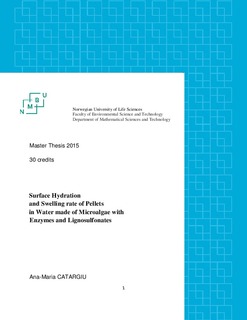| dc.description.abstract | Water quality, pollution, shrimp growth and survival and decreasing shrimp disease have always been looked at as challenges regarding shrimp feed. These issues are related and could be resolved by improving the pellet physical quality parameters. The compounded diet for shrimp therefore, should be well bound to withstand feeding manipulation and the challenges that come with it. In order to optimize feed intake and reduce wastage, artificial diets for shrimps need to be formulated and manufactured by taking into account species behavior, physiological requirements and the physical processes of ingestion.
Lignosulfonate is another additive that can be used as a means of incorporating fat-soluble nutrients into water-based foods. This can help in improving pellet physical qualities. The usefulness of commercial lignosulfonate products comes from their dispersing, binding, complexing agent, and emulsifying properties.
Enzymes are defined as catalysts that increase the speed of the processes in which they are involved. The addition of enzymes to aquatic feed has the potential of improving the nutritional value of the feed by reducing their loss to the environment due to the inactivation of anti-nutritional factors, therefore reducing production costs.
Microalgae are able to raise the nutritional content and value of conventional food preparations and hence, to affect the health of humans and animals in a positive way. This is due to their original chemical composition that has a very good comparable level of protein some common foods used daily in human nutrition. Microalgae could substitute fish meal at a very high level and with these helps the environment by being sustainable in its production.
The last part of the present thesis contains an experiment that had its main goal in determining how addition (in a dry matter basis) of lignosulfonate and enzyme (NSP and protease) influences the physical quality of microalgae pellets. The pellets were produced using a single pellet press method. Four experimental diets were formulated: one control diet with 100% microalgae (C) and other three with addition of Lignosulfonate (LS), non-starch polysaccharides (NSP) and protease to C diet in a percentage of 0.5, 0.01 and 0.006 respectively. Characterization of their effect on tensile strength (durability of pellets), the water absorption rate and underwater swelling rate is presented. The results showed that the additives protease and non-starch polysaccharide enzyme (NSP) decreased the tensile strength of pellets when added in their respective percentages. Lignosulfonate additive (LS) did not change the tensile strength when added in 0.5% (dry basis). Protease, NSP and LS increased the water activity, decreased the swelling of pellets under water, increased hydrophobicity and lowered absorption rate of a sessile water drop sitting on the pellet surface. Protease produced the highest water activity, the lowest swelling of the pellets and the highest initial contact angle (i.e. the most hydrophobic) followed by LS and NSP. Pellets made of pure microalgae had the lowest water activity, the lowest hydrophobicity and the highest swelling and absorption rate of the sessile drop. | nb_NO |
